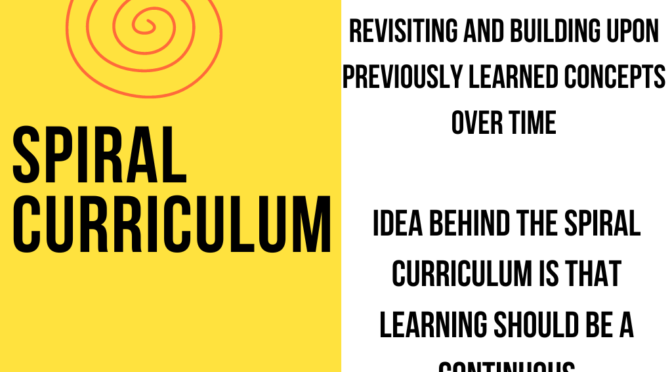The Spiral Curriculum is a teaching approach that emphasizes revisiting and building upon previously learned concepts over time. It was developed by Jerome Bruner, a psychologist and educator, in the 1960s.
The idea behind the Spiral Curriculum is that learning should be a continuous, interconnected process. Instead of teaching new concepts in isolation, the Spiral Curriculum emphasizes revisiting and building upon previously learned material, allowing students to deepen their understanding and develop a more sophisticated grasp of the material.
In the Spiral Curriculum, students are first introduced to a basic concept, which is then revisited and built upon in subsequent lessons. Each time the concept is revisited, it is presented in a more complex or nuanced way, allowing students to deepen their understanding and develop a more sophisticated grasp of the material.
This approach is often contrasted with the traditional linear curriculum, in which new concepts are introduced one at a time and each topic is taught in isolation from the others. The Spiral Curriculum is intended to help students make connections between different subjects and develop a more holistic understanding of the material.
Here are some key characteristics of the Spiral Curriculum:
- Emphasis on foundational knowledge: It begins with foundational knowledge or basic concepts. These concepts are then revisited and built upon in subsequent lessons, allowing students to develop a deeper understanding of the material.
- Building complexity: Each time a concept is revisited, it is presented in a more complex or nuanced way. This allows students to develop a deeper and more sophisticated understanding of the material.
- Interdisciplinary connections: It emphasizes connections between different subjects. By revisiting previously learned material, students can make connections between different subjects and develop a more holistic understanding of the material.
- Active learning: It emphasizes active learning, such as problem-solving and critical thinking. Instead of just memorizing facts, students are encouraged to engage with the material and think critically about it.
- Lifelong learning: It is designed to help students develop a deep and lasting understanding of the material. By emphasizing foundational knowledge, building complexity, and interdisciplinary connections, the Spiral Curriculum helps students develop the skills and knowledge they need to continue learning throughout their lives.
Overall, the Spiral Curriculum is a teaching approach that emphasizes building upon previously learned material over time. By revisiting and deepening their understanding of foundational knowledge, students can develop a more sophisticated understanding of the material and the skills they need for lifelong learning.
Also Read : Eclectic model of Curriculum Design

Also Visit : Prep with Harshita

